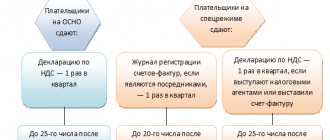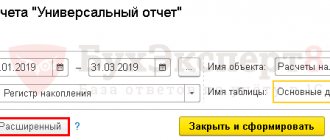Home — Articles
- Submission of reports when the location of the organization changes during the year
- Is it necessary to submit personal income tax reporting for employees working abroad?
- Is an organization a tax agent for personal income tax when paying an employee remuneration for work-related inventions?
- Is it possible in an agreement to assign the obligation of a tax agent for personal income tax to an organization?
- Holding accountable for violations in reporting
The composition of personal income tax reporting for tax agents is specified in Art. 230 Tax Code of the Russian Federation. According to paragraph 2 of this article, tax agents submit the following forms to the tax authority at their place of registration.
The forms, formats and procedure for submitting these reports are approved by the federal executive body authorized for control and supervision in the field of taxes and fees:
- for reference on form 2-NDFL - Order of the Federal Tax Service of the Russian Federation dated October 30, 2015 N ММВ-7-11/ [email protected] Order of the Federal Tax Service of the Russian Federation dated September 10, 2015 N ММВ-7-11/ [email protected] approved codes for types of income and deductions ;
- for calculation in form 6-NDFL - by Order of the Federal Tax Service of the Russian Federation dated October 14, 2015 N ММВ-7-11/ [email protected]
About the 2-NDFL certificate
The following must be entered into this form:
- Full information about the employer (company name, its details).
- Information about the employee (full name, tax identification number, passport information, place of residence).
- Monthly income, 13% - this is his rate.
- Information about the required deductions with their codes (standard deduction, social or property).
- Amounts of tax withheld.
- Total amounts (income, deductions and taxes).
Certificates of this form are issued by:
- An individual who has income from which tax is levied by the employer.
- An individual who has income from which the employer does not levy tax.
Filling out this certificate is carried out on a specially designed form. The new form has a barcode in the upper left corner, which was assigned in accordance with the rules. Further information is filled in in the following order:
- the period for which the certificate was issued;
- tax agent (employer);
- employee information;
- information about income taxed at a rate of 13% (it is important to indicate the income code);
- information about tax deductions;
- information about total income and taxes.
The Ministry of Finance has expanded the list of payments that are not subject to personal income tax
According to Federal Law No. 147-FZ dated June 17, 2019, these payments relate to certain types of income:
- payment by the employer of the cost of travel to the vacation destination in Russia for employees working or living in the Far North;
- compensation payments to health workers up to 1 million rubles;
- compensation in exchange for the due land plot;
- income received by Heroes of the Soviet Union and the Russian Federation and Heroes of Labor;
- payments to citizens exposed to radiation;
- income received in connection with the birth of a child;
- income received by disabled people or disabled children, as well as the amount of payment for additional days off provided to persons caring for them;
- income received as part of social support;
- payments to honorary donors.
How to fill it out correctly?
It is important to have information about the correct completion of the annual report 6-NDFL and 2-NDFL, since it is accepted by the Russian tax service, while 2-NDFL certificates are issued to employees of the enterprise at their request, for example, to a bank.
Amounts are entered in certificates in rubles with the obligatory indication of kopecks, except for income tax. It is provided in full in rubles. If the amount was in kopecks, then less than 50 kopecks. are discarded, and more than 50 kopecks are rounded, and one is added to the amount in rubles.
If different rates were applied to the employee’s income throughout the year, then points 3-5 will be equal to their number.
Where to submit information
Quarterly reports must be submitted to the Federal Tax Service office at the place of registration of the organization. There are a number of nuances that need to be taken into account:
- if the company has separate divisions, then documents are submitted to the inspection department at the location of these objects;
- large firms report at the place of registration or at the location of each division;
- Individual entrepreneurs transmit reports to their place of registration if they work under the patent system or UTII.
These provisions are listed in the law being commented on and must be taken into account when submitting documents.
Actions to take if there is an error in the help
There are times when errors are made in the certificate. In this case, you need to act in accordance with the procedure for correcting errors. The header has a special field “Adjustment number”. The adjustments have their own numbers:
- “00” means filling out the primary form;
- “01”, “02”, etc. are indicated when filling out the corrected certificate, which is issued in place of the previous one, one more than what was indicated in the previous certificate;
- “99” means cancellation of the certificate.
The corrected form of the 2-NDFL annual report form is submitted to eliminate an error in the form that was submitted initially, and the cancellation form is submitted to cancel data that is unnecessary to provide. If the tax authority does not accept the certificate (for this purpose errors with format control are indicated in the protocol), a new certificate is written, not an adjustment. Therefore, when filling out a new certificate, indicate the number “00” and the new date.
How reporting is transmitted
Today you can submit documents in form 2-NDFL in paper and electronic form. Let us remind you that now the permissible number of people for submitting documentation in standard paper form has been increased from 10 to 25. In addition, there are several new fundamental points:
- reporting is transmitted exclusively through telecommunication channels;
- any media that was previously used (DVD, CD, USB) will be prohibited from the beginning of next year.
Thus, large organizations will now need to use special programs to submit information electronically. As a rule, they all work with the popular 1C system.
What is the due date?
A certificate indicating the income of the organization’s employees must be submitted within a certain time frame. The tax agent provides information about the income of employees according to the 2-NDFL certificate of the Federal Tax Service at the place of registration. The reporting period will be the past tax period. The amounts of taxes accrued, withheld and transferred to the budget of the Russian Federation are indicated there.
The report must be submitted every year on time, in the form, format and procedure approved by the federal executive services authorized for inspections and supervision in the field of taxes and fees.
Information must be provided in electronic form using telecommunication channels or in paper format (on electronic media). If, since the beginning of 2021, an enterprise has paid income to 25 employees or more, it must submit 2-NDFL certificates for 2021 in electronic format using telecommunication channels through an operator who deals with electronic document management. You cannot use hard drives, flash drives, etc. If the employer paid income to less than 25 employees during the tax period, then the certificates are provided in paper format.
These amendments are provided for in paragraph 2 of Article 230 of the Tax Code of the Russian Federation. They also apply to the 2015 reports. Accordingly, if an employer transferred income to 25 or more employees in 2015, the information should be provided only via the Internet.
Information about the impracticability of tax withholding for 2021 must also be provided electronically if the employer has transferred income to a minimum of 25 employees.
At the end of the year, the employer must provide a certificate, for example, 2-NDFL for 2021, to the inspectorate:
- No later than the first of March from Fr. Such a certificate is issued for those employees from whose income personal income tax is not withheld (for example, providing financial assistance or giving gifts to persons who do not work in the organization in an amount of more than 4,000 rubles.
- Until the first day of April from Fr. Here you can find information about the total amount of income earned for the previous year, the tax base from which personal income tax is withheld.
These are the deadlines for submitting the 2-NDFL annual report.
Is it necessary to submit personal income tax reporting for employees working abroad?
With regard to the income of employees of an organization in the form of remuneration for the performance of labor duties received from sources outside the Russian Federation, the employing organization is not recognized as a tax agent. Therefore, she cannot be assigned the duties provided for tax agents in Art. 226 (calculation and payment of tax) and 230 (submission of reports) of the Tax Code of the Russian Federation.
In Letter dated December 22, 2016 N 03-04-06/76921, financial department specialists considered the following situation. A Russian organization sent its employee, a citizen of the Russian Federation, to work abroad. The employment contract defines his place of work as a foreign country. At the same time, his wages are paid by his employer, a Russian company. In this regard, the organization had a question: is it, in this case, a tax agent for personal income tax?
Note. The organization is not a tax agent in relation to the wages of employees who perform their work duties in a foreign country.
The Ministry of Finance answered this question in the negative. He gave the following arguments to support his position. According to paragraphs. 6 clause 3 art. 208 of the Tax Code of the Russian Federation, remuneration for performing labor duties outside the Russian Federation refers to income received from sources outside the Russian Federation. In paragraph 2 of Art. 226 of the Tax Code of the Russian Federation establishes that the calculation and payment of tax are carried out by a tax agent in relation to all income of an individual, the source of which is a tax agent, with the exception of income on which tax is calculated and paid, including in accordance with Art. 228 Tax Code of the Russian Federation. By virtue of paragraphs. 3 p. 1 art. 228 of the Tax Code of the Russian Federation, if employees receiving remuneration for performing work duties outside the Russian Federation are recognized as tax residents, they calculate, declare and pay personal income tax independently at the end of the tax period.
In the case where employees are not tax residents, their income received from sources outside the Russian Federation is not recognized as subject to personal income tax (Article 209 of the Tax Code of the Russian Federation).
For your information. If an employee under an employment contract for remote work outside the Russian Federation receives income in the form of remuneration for performing work duties and is at the same time a resident of the Russian Federation, in accordance with paragraphs. 3 p. 1 art. 228 of the Tax Code of the Russian Federation, he must calculate, declare and pay personal income tax independently at the end of the tax period (Letter of the Ministry of Finance of the Russian Federation dated April 1, 2016 N 03-04-06/18555).
Let us note that the Ministry of Finance has previously expressed the opinion that an organization should not perform the functions of a tax agent in relation to remuneration for the performance of labor duties to its employee received from sources outside the Russian Federation (Letters dated 04/29/2016 N 03-04-06/25339, dated 07/15/2015 N 03-04-06/40525).
Help 6-NDFL
Certificate 6-NDFL is a document for reporting by an employer paying income to individuals. Presented as a summary of general information about employee income for a certain period and the tax withheld on these amounts. Reporting is submitted quarterly, that is, every three months. Reporting must be submitted electronically. But if the organization has less than 25 employees, you can send it in paper format.
When filling out the certificate, you need to make sure that all the boxes are filled out. Empty columns are filled in with a dash, both on the title page and on the second page. All tax agents are required to submit this form. These include individual entrepreneurs, lawyers, and notaries. Income should be reflected for all individuals who work at the enterprise. When talking about income, we mean wages, dividends, and remuneration under civil contracts.
Insurance premiums: clarifications on the procedure for paying contributions and submitting the DAM
The Tax Code regulations regarding insurance premiums will change as follows from January 1, 2021.
Firstly, the range of situations will be narrowed when an organization with separate divisions must send DAM and pay contributions at the location of each authorized “separate division”. Starting next year, these duties will need to be fulfilled if two conditions are met: the unit makes payments in favor of individuals and has an independent bank account (new editions of clauses 7 and 11 of Article 431 of the Tax Code of the Russian Federation). Thus, the norms of the Tax Code of the Russian Federation will correspond to the provisions of the laws on compulsory social insurance, which initially provided for the registration of only those divisions of the insurer that have bank accounts (subclause 3 of clause 1 of Article of the Federal Law of December 15, 2001 No. 167-FZ , subparagraph 2, paragraph 1, article 2.3 of the Federal Law of December 29, 2006 No. 255-FZ and subparagraph 2, paragraph 1 of Article 2.3 of the Federal Law of July 24, 1998 No. 125-FZ).
Secondly, as mentioned above, from January 1, 2021, the threshold for the number of employees at which the policyholder must submit the DAM electronically according to the TKS is being reduced. Such an obligation will appear for those payers who, during the billing or reporting period, accrued payments and remuneration under employment contracts or contracts (for the provision of services) to at least 11 individuals (new edition of clause 10 of Article 431 of the Tax Code of the Russian Federation). The new headcount criterion must be taken into account when submitting the DAM for 2021 and later periods. Let us also remind you that starting from the calculation for the first quarter of 2021, you need to use the new DAM form (approved by order of the Federal Tax Service dated September 18, 2019 No. ММВ-7-11 / [email protected] ). For more information about the new DAM form, see “How the form of calculation for insurance premiums will change in 2021.”
Fill out and submit the current DAM form online for free
How to submit the annual report 6-NDFL?
It is important to know that the report must be submitted incrementally, four times a year:
- in the first quarter;
- in half a year;
- at 9 months;
- in year.
In accordance with the law, quarterly reporting on this form is submitted to the inspectorate no later than the beginning of the last day of the month following the reporting quarter. The annual count is sent by the first day of April of the following year. There is a penalty for late submission of the report. For each month of delay, the cost is one thousand rubles. So it’s better to try to submit 6-NDFL reports on time starting from 2021.
Such a certificate can be submitted in paper form only to those organizations whose number of employees is less than 25.
Responsibility for late submission of reports
Penalties for late submission of documents and payment of taxes are being tightened. According to the state, this can be compared to the illegal use of budget funds. The ability to challenge sanctions imposed by the tax authority in court and the low level of fines impede the filling of the budget. The small amount of information that Federal Tax Service employees currently have hinders control over tax collection. Thus, a situation may arise in which employees’ contributions to the budget are withheld in full, but they do not go directly to the treasury. From 2021, the following changes will be introduced to legislation:
- if quarterly reporting is not submitted on time, it will cost 1,000 rubles for each month that is completely or partially overdue;
- if the tax service’s account does not receive funds within ten days after the end of the billing period, then the payer’s transactions on bank accounts, including those carried out electronically, may be suspended;
- For false information, a fine equal to 500 rubles per document is imposed.
In the latter case, a fine of 200 rubles is currently provided for failure to submit a document. In total, for falsified or unverified data, the tax agent will have to pay 700 rubles from the beginning of next year.
Sample certificate 6-NDFL
The sample annual report 6-NDFL has been valid for about a year, but tax agents and accountants have many questions about filling it out.
The certificate has a title page and a second page, which has two more sections. If there are not enough lines for the report, you can number additional sheets. Usually there is not enough space when filling out the second section, which is on the same page as the first. In this case, there is no need to copy the contents of the first section.
In the footer of the first sheet, fill in the TIN and KPP of the organization that submits the reports. If the information is provided by a branch of the company, then the checkpoint of the branch is filled out.
Under the heading there is a line “Adjustment number”, suggesting the ways in which the report is filled out. If errors or inaccuracies are found in the report, they can be corrected by sending a modified version of the report. Accordingly, if the report is sent for the first time, three zeros are indicated in the required column. If it is necessary to clarify the calculations, indicate the numbers “001”, “002”, etc.
Previously, when submitting personal income tax reports, the year was not divided into reporting periods; accordingly, according to the Tax Code of the Russian Federation, the “reporting period” in relation to this tax did not matter. Now the value “submission period” has been added to the sample report; this is the deadline for submitting the annual 6-NDFL report for which the report is submitted.
Below is the tax code to which the employer sends reports. The code is four digits: the first two numbers are the region number, and the second two numbers are the inspection code. It is necessary to remember that the report is submitted to the inspectorate at the actual location of the enterprise or branch. Individual entrepreneurs send reports to the tax office at their place of residence.
By the code in the line “By location (accounting)” you can determine which organization submits the report. These codes are indicated in the Procedure for filling out the annual report 6-NDFL:
- where the Russian organization is registered – “212”;
- where the branch is registered;
- large taxpayers indicate “213”;
Individual entrepreneurs have their own codes:
- IP on the simplified tax system or the general system - “120”.
- Individual entrepreneur on UTII or patent – “320”.
In the line about the tax agent, indicate the name of the organization. You can also indicate a short name, if available.
When filling out the All-Russian Classifier of Municipal Territories (OKTMO), it is mandatory to indicate the code of the entity on the site of which the organization or its branch is located and registered (when submitting a report for the branch). That is, annual report code 6-NDFL. It happens that employees receive income, such as wages, bonuses, etc., both from the parent company and from its divisions. In such a situation, the inspectorate is provided with two calculations with different OKTMO codes.
New reporting rules for companies with separate divisions
Since 2021, an innovation has been introduced for tax agents who have at their disposal several separate divisions on the territory of one municipality, that is, within one OKTMO. They will have the opportunity to submit tax reports on personal income tax and transfer withheld personal income tax amounts to the budget at the place of registration of the organization itself or one of its separate divisions. You must notify the tax authority of your choice.
Now such organizations submit reports at the place of registration of both the parent organization and each separate division. But large companies with a large branch network are extremely inconvenient to transfer personal income tax in this mode.
You no longer need to go to inspections - Extern will deliver your report on time and without errors.
To learn more
There is good news for organizations with several separate divisions in another municipality. It will be possible to select a responsible person from among the separate divisions.
It is planned that the innovations will come into effect in 2021. That is, with regard to calculations accepted by 6-NDFL starting from 2021 and for the tax that will be paid in 2021, the new procedure can already be applied.
Second page of the 6-NDFL certificate
On the second page of the help, there are two more sections to fill out, each of which in turn is divided into subsections.
The first subsection of the generalized indicators indicates the tax rate that is used in the organization. At one enterprise, employee income tax is calculated at several rates. The basic rate is 13%. The rest, high rates, are used in relation to individuals non-residents of Russia (15 and 30%), and in relation to winnings in a lottery, competition or promotion (35%). If the organization uses only the basic rate, then the section is filled out once.
The second subsection summarizes the results for all income tax rates used.
The second subsection indicates the total values. The line contains the number of employees who received accruals for the period. In cases where an employee quit and then returned to the organization, the information does not change.
There are cases when in the annual reports 6-NDFL and 2-NDFL, the tax withheld does not coincide with the amount of calculated tax. This happens due to the fact that some tax amounts were transferred earlier and withheld from employees later.
They also indicate the amount of personal income tax that could not be withheld for some reason.
The second section of 6-NDFL for the last quarter contains information, that is, the period from the beginning of the year is not taken into account. Here the dates of accrual of income to employees and their amounts are filled in. Dates are indicated in chronological order:
- The date on which the employee received income. The specified date and month depend on the type of payment. The day that the employee receives income also depends on this type. The salary, therefore, is the income of an individual received at the end of the month (issued on the last day) for which it is paid, that is, the last day is indicated, for example, January 2021, and the employee received the salary for this month in February. Vacation and sick pay are income on the day they are received.
- The date when the tax was withheld by the enterprise. Personal income tax must be collected from earnings on the day it is paid. Employee income tax on vacation pay or sick leave is also withheld by the company on the day they are paid.
- The date of deduction of the tax amount to the budget in accordance with the law. Tax on wages must be paid into the budget the next day after payment, no later, and on vacation and sick leave before the end of the month in which they were paid.
- The amount that employees received on a specific date, before taxes were deducted.
- The amount of tax withheld upon payment of income to employees on the date of tax withholding by the enterprise, regardless of transfers to the budget.
When checking 6-NDFL and 2-NDFL, it is necessary to check their internal data, but also compare the 6-NDFL sample with other statements, and with information from accounting and tax registers.
The Tax Code of the Russian Federation predetermines the deadlines for providing information on the income of employees of the organization and the amount of tax withheld, calculated and transferred to the budget of the Russian Federation for the year for each employee according to the annual report 6-NDFL and 2-NDFL.
The deadlines for submitting these reports are the same: no later than the beginning of April of the year following the previous tax period. If the last day for submitting reports falls on a weekend or non-working holiday, submitting reports is allowed on the next working day. For example, if the first day of April falls on a Saturday, then the deadline for submitting reports on forms 2-NDFL and 6-NDFL is the 3rd.
In some cases, employers will pay personal income tax for employees
Federal Law No. 325-FZ dated September 29, 2019 provides for amendments to Art. 226 Tax Code of the Russian Federation.
Previously, payment of personal income tax at the expense of a tax agent was not allowed. Starting next year, changes have been made, and now the tax agent will pay personal income tax at his own expense in the event of additional tax amounts being assessed to him during an audit.
Thus, if in 2021 the tax authority, during a desk or field tax audit, establishes the fact of non-withholding or incomplete withholding of tax, then the tax authority’s decision to prosecute will indicate that the tax agent must pay a certain amount of personal income tax.
Most likely, a decision will be made to apply this norm in inspections starting from January 1, 2021. All that remains is to wait for an official letter with clarification from the Federal Tax Service.
Correspondence of annual reports 2NDFL and 6NDFL
It’s not just the filing deadlines that these reports have in common. The letter from the Federal Tax Service of Russia indicates control ratios for them.
For the annual calculation of 6-NDFL, the final ratio is applied to the annual certificate 2-NDFL, which has the sign “1” (indicating the total amount of income earned by the employee for the previous year, the tax base from which tax amounts were withheld). Since the 6-NDFL certificate contains generalized information, and the 2-NDFL certificate is filled out separately for each employee who earned their income in the form of salary at the enterprise, when checking 6-NDFL and 2-NDFL, some data must match:
- The number of employees who earned income during the reporting period should not differ from the total number of 2-NDFL certificates provided.
- According to the tax rates (each of them), the accrued income must be equal to the total of the lines “total amount of income” for all 2-NDFL certificates, and the tax rate will be exactly the same.
- Dividend income must be equal to the amount of the same income on all 2-NDFL certificates.
- The full tax, which is withheld from the employee’s total income in rubles without kopecks, must be equal to the amount of the line “calculated tax amount” for all forms of 2-NDFL with the corresponding rates.
- The tax not withheld for any reason from an individual must be equal to the amount of tax that the tax agent did not withhold in all certificates.
In reports in 6-NDFL and 2-NDFL, discrepancies are not allowed.
Reporting of tax agents on personal income tax
Organizations that make payments to individuals under employment and civil contracts are tax agents for personal income tax.
They are required to calculate, withhold and pay taxes to the budget, as well as report to the tax office. Sergei Razgulin, Actual State Advisor of
the Russian Federation, 3rd class, is devoted to issues related to the preparation and presentation of personal income tax . also calculated and withheld personal income tax amounts?
Tax accounting during the tax period (calendar year (Article 216 of the Tax Code of the Russian Federation)) is maintained in the appropriate register, which is compiled for each individual.
This document must allow one to identify the individual taxpayer, the type of income paid to him and the tax deductions provided, the amount of income, the date of payment, the tax status of the individual, the dates of withholding and transfer of personal income tax to the budget, as well as details of the payment document.
The tax agent independently develops and approves by order the form of the register and the procedure for reflecting analytical data and data from primary accounting documents in it. In practice, this form is included in the annexes to accounting policies for tax purposes.
Based on the register data, a 2-NDFL certificate (approved by order of the Federal Tax Service of Russia dated October 30, 2015 No. ММВ-7-11/ [email protected] ) and a calculation according to form 6-NDFL (approved by order of the Federal Tax Service of Russia dated October 14, 2015 No. ММВ) are filled out -7-11/ [email protected] ).
What sanctions does the legislation provide for the lack of registers?
By virtue of Article 120 of the Tax Code, the absence of registers is recognized as a gross violation of the rules for accounting for income, expenses and objects of taxation. It entails a fine of 10,000 rubles.
The same article recognizes as a violation the systematic (twice or more times during a calendar year) untimely or incorrect reflection in the registers of business transactions.
At the same time, erroneous reflection of the date of actual receipt by an individual of income in the form of wages as the date of its payment is not grounds for prosecution under Article 120 of the Tax Code (letter of the Ministry of Finance of Russia dated April 18, 2014 No. 03-04-06/17867).
Are registers included in the list of personal income tax reporting that an organization submits to the tax office?
The registers themselves are not included in the list of reports submitted by the tax agent. However, if necessary, inspectors can request them (Article 93 of the Tax Code of the Russian Federation).
According to the Tax Code, the organization submits to the inspectorate at the place of its registration documents containing information for the expired tax period on the income of individuals and the amounts of tax calculated, withheld and transferred to the budget (clause 2 of Article 230 of the Tax Code of the Russian Federation) (form 2-NDFL for each an individual).
Codes of types of income and deductions for filling out form 2-NDFL (order of the Federal Tax Service of Russia dated September 10, 2015 No. ММВ-7-11 / [email protected] ), as well as the procedure for its submission (order of the Federal Tax Service of Russia dated September 16, 2011 No. ММВ-7- 3/ [email protected] ) are established by the Federal Tax Service of Russia in separate orders.
I would like to note that starting from 2021, some income and deduction codes have been excluded and new ones have been introduced (Order of the Federal Tax Service of Russia dated November 22, 2016 No. ММВ-7-11/ [email protected] ). At the same time, the website of the Federal Tax Service of Russia contains information on the use of new codes when filling out reports for 2021 (https://www.nalog.ru/rn77/news/tax_doc_news/6358196/).
The deadline for submitting form 2-NDFL is annually no later than April 1 of the year following the expired one (Clause 2 of Article 230 of the Tax Code of the Russian Federation). When the last day of the period falls on a day recognized in accordance with the legislation of the Russian Federation as a weekend and (or) a non-working holiday, then the end of the period is considered to be the next working day following it (Clause 7, Article 6.1 of the Tax Code of the Russian Federation).
In 2021, a new reporting form appeared - “Calculation of personal income tax amounts calculated and withheld by the tax agent” (form 6-NDFL) (approved by order of the Federal Tax Service of Russia dated October 14, 2015 No. ММВ-7-11 / [email protected] ).
All tax agents are required to report on it, including persons recognized as tax agents when carrying out transactions with securities (Article 226.1, paragraphs 2, 4 of Article 230 of the Tax Code of the Russian Federation).
The calculation contains generalized information in general for all individuals (clause 1 of Article 80 of the Tax Code of the Russian Federation), without specific personal data.
It is filled out with a cumulative total for the reporting dates: March 31, June 30, September 30, December 31 and submitted to the tax office no later than the last day of the month following the corresponding reporting period. For the tax period, calculations are submitted no later than April 1 of the following year (clause 2 of Article 230 of the Tax Code of the Russian Federation).
Let me note that if an income payment operation began in one reporting period and is completed in another, then it is reflected by the tax agent in the calculation of 6-NDFL for the period in which it was completed (letter of the Federal Tax Service of Russia dated February 12, 2016 No. BS-3-11/ [ email protected] ).
Even if the organization did not make payments to an individual, I recommend submitting a “zero” calculation in Form 6-NDFL, despite the presence of clarifications from the Federal Tax Service of Russia with a different position (letter of the Federal Tax Service of Russia dated August 1, 2016 No. BS-4-11 / [email protected] ).
How are tax agent reports checked?
Law enforcement practice proceeds from the fact that 2-NDFL certificates are not a declaration (calculation) and are not subject to desk verification (letter of the Federal Tax Service of Russia dated 08/09/2016 No. GD-4-11/14515).
Form 6-NDFL undergoes a desk audit (Articles 80, 88 of the Tax Code of the Russian Federation). At the same time, although inspectors cannot request documents (clause 7 of Article 88 of the Tax Code of the Russian Federation), in particular, they have the right to request clarification in cases of errors or contradictions between the information presented and the information available to them. The company must provide any necessary clarifications or corrections within five business days.
The bulk of requests for explanations on the calculation of 6-NDFL are expected at the end of the tax period - after the submission of certificates in form 2-NDFL, which contain detailed information about each individual recipient of income.
If violations are detected based on the results of a desk audit, an act is drawn up (clause 1 of Article 100 of the Tax Code of the Russian Federation).
Let me remind you that delay in transferring personal income tax leads not only to the accrual of penalties, but also to the collection from the tax agent of a fine in the amount of 20 percent of the amount subject to withholding and (or) transfer (Article 123 of the Tax Code of the Russian Federation). The penalty is applied to each fact of non-withholding, including that committed before the expiration of the tax period.
Does an organization need to submit to the inspectorate information about income paid to an individual entrepreneur in connection with his business activities?
No no need. The organization is not recognized as a tax agent in relation to such payments (subclause 1, clause 1, article 227 of the Tax Code of the Russian Federation).
The “entrepreneurial” income status is confirmed by a civil contract, which includes details of the certificate of state registration of an individual as an individual entrepreneur, or the presence of a copy of the certificate of such registration (letter of the Ministry of Finance of Russia dated March 21, 2011 No. 03-04-06/3-52 ).
In what cases can information on form 2-NDFL and calculation of 6-NDFL be submitted to the inspectorate on paper?
An organization submits Form 2-NDFL on paper (in person, through a representative or by post with a list of attachments), when the number of individuals who received income from it in the tax period that is subject to personal income tax is 24 people or less (clause 2 of Art. 230 of the Tax Code of the Russian Federation).
For the purpose of presenting the calculation of 6-NDFL, the above number is checked for a quarter, half a year, nine months and a year.
If this requirement is not met, then form 2-NDFL and calculation 6-NDFL are submitted in electronic form exclusively via telecommunication channels (hereinafter referred to as TCS).
At the same time, failure to comply with the method of presentation does not mean that the tax agent’s obligation to submit reports was not fulfilled.
Thus, the inspectorate does not have the right to refuse to accept 6-NDFL on paper from an organization from which more than 24 people received taxable income. However, she will be charged a fine of 200 rubles (Article 119.1 of the Tax Code of the Russian Federation) for failure to comply with the procedure for submitting the calculation.
Does the successful submission of reports (in person or through a representative, by post, via TKS) indicate its acceptance by the inspectorate?
For each of the listed methods, its own date is defined, which records the moment of presentation.
In this case, information that has passed format control is considered to be submitted (clauses 11, 17, 30 of the Procedure for submitting to the tax authorities information on the income of individuals and messages about the impossibility of withholding tax and the amount of tax on personal income, approved by order of the Federal Tax Service of Russia dated September 16, 2011 No. ММВ-7-3/ [email protected] ).
Depending on the reasons that caused the failure to pass the control, the issue of bringing the tax agent to justice is decided.
If reporting is submitted not in person or by mail, but by TKS, it is advisable to send it in advance.
Within 10 working days from the date of dispatch, the inspectorate must send to the tax agent in electronic form for the corresponding year a register of information on the income of individuals and a protocol for receiving information on the income of individuals, which may contain information about errors. The time reserve will allow the organization to clarify the reporting if necessary.
For clarification, only the information that has been corrected should be submitted to the inspectorate. So, if, when sending via TKS, information containing errors is identified in the reception protocol, then only the corrected (corrected) information is sent again. The entire file is not resubmitted.
How should organizations that include separate divisions report?
The Tax Code requires submitting reports to the inspectorate both at the location of the organization itself and at the location of its separate divisions (in relation to employees of a separate division, as well as individuals who received income under civil contracts concluded with an organization represented by a separate division) (Clause 2 of Article 230 of the Tax Code of the Russian Federation).
Reporting is generated separately for each separate division, regardless of the fact that the organization may be registered at the location of the separate divisions in the same inspectorate.
Submission of reports to the relevant tax authorities can be carried out both by the parent organization and directly by separate divisions.
For the purposes of presenting information, the presence or absence of a separate balance sheet or current account at a separate division does not matter. The place of residence of an individual also does not matter.
A situation is possible when an individual, during the tax period or even during the month of the tax period, worked both in a separate division and in the parent organization. In this case, the payment of personal income tax and the presentation of information are carried out taking into account income accrued in proportion to the time worked in each place (letter of the Ministry of Finance of Russia dated March 29, 2010 No. 03-04-06/55).
How to report when closing a separate division?
The Tax Code does not regulate this situation. During the tax period, before deregistration, I recommend submitting reports to the inspectorate at the location of the closed separate division for the period from the beginning of the calendar year to the day of closure. There is no need to re-submit reports at the end of the calendar year.
Tell us about the features of the tax agent’s presentation of information on the income of individuals from transactions with securities.
Brokers, depositories, trustees (Article 226.1 of the Tax Code of the Russian Federation) when carrying out transactions with securities, with financial instruments of futures transactions, payments on securities of Russian issuers (coupons, dividends on shares) provide information on income received by individuals in Appendix No. 2 to declarations on corporate income tax (“Information on the income of an individual paid to him by a tax agent from transactions with securities, transactions with derivative financial instruments, as well as when making payments on securities of Russian issuers” (approved by order of the Federal Tax Service of Russia dated 19.10 .2016 No. ММВ-7-3/ [email protected] )). The document is submitted only for the tax period (for 2016 - no later than March 28, 2017). Form 2-NDFL is not submitted for such income.
In this case, the tax agent draws up separate certificates not only for each individual, but also separately for each type of income, which is taxed at different rates.
Please note that despite the fact that information is submitted in a form that is an appendix to the tax return, liability associated with its failure to submit arises on the basis of Article 126 of the Tax Code, which deals with the document. The fine is 200 rubles for each unsubmitted document (Clause 1 of Article 126 of the Tax Code of the Russian Federation).
Information on dividends paid that are not related to dividends on shares of Russian organizations is presented in Form 2-NDFL (clause 2 of Article 230 of the Tax Code of the Russian Federation; letter of the Ministry of Finance of Russia dated January 29, 2015 No. 03-04-07/3263).
Let's assume that the tax agent was unable to fully withhold the personal income tax amount for the tax period. What information is he required to provide in this case?
The tax agent informs the individual and the inspectorate at the place of his registration in writing about the impossibility of withholding the calculated amount of personal income tax no later than March 1 of the year following the tax period (Clause 5 of Article 226 of the Tax Code of the Russian Federation).
According to the clarifications of the Ministry of Finance of Russia (letter of the Ministry of Finance of Russia dated December 29, 2011 No. 03-04-06/6-363), a message about the impossibility of withholding tax does not relieve the tax agent from the obligation to provide information on the income of individuals for the expired tax period and the amounts accrued, withheld and transferred to the personal income tax budget. The Federal Tax Service of Russia adheres to a similar position (letter of the Federal Tax Service of Russia dated March 30, 2016 No. BS-4-11/5443).
Since, according to the current version of the Tax Code, we are talking about the fulfillment of two obligations - to report the impossibility of withholding and to report the income of an individual, it is advisable to send the relevant certificates twice to the inspectorate in form 2-NDFL (for example, submit a certificate for 2021 with the sign “2” - no later than 03/01/2017 and a certificate for 2021 with the sign “1” - no later than 04/03/2017).
The certificate with attribute “1” indicates the amounts including income and the calculated amount of tax, as well as unwithheld tax amounts that were previously reflected in the certificate with attribute “2” (letter of the Ministry of Finance of Russia dated October 27, 2011 No. 03-04-06/8 -290).
I would like to note that liability for failure to submit a certificate (Article 126 of the Tax Code of the Russian Federation) can be avoided if the certificate with attribute “2” contained all the necessary information to be indicated in the certificate with attribute “1” (reg. FAS UO dated September 24, 2013 No. F09- 9209/13).
The tax agent does not withhold the amount of debt reflected in the certificate from the individual’s income subsequently paid to him.
With regard to the information on the income of individuals from transactions with securities discussed in the previous question, there are some features of sending information if the withholding of personal income tax turned out to be impossible.
The tax agent is obliged to inform the inspectorate in writing about the impossibility of withholding personal income tax based on the results of the tax period no later than March 1 of the following year (clause 14 of Article 226.1 of the Tax Code of the Russian Federation). In this case, the form of the message can be arbitrary.
In what case is a tax agent obliged to provide an individual with a certificate of income received and personal income tax amounts withheld?
If an individual submits a corresponding application, the tax agent is obliged to issue a 2-NDFL certificate (clause 3 of Article 230 of the Tax Code of the Russian Federation; letter of the Ministry of Finance of Russia dated December 1, 2014 No. 03-04-06/61255). At the same time, the Tax Code does not establish deadlines for issuing such a certificate, as well as liability for its non-issuance (untimely issuance).
However, according to the Labor Code, the employer is obliged, no later than three working days from the date of submission of the employee’s written application, to provide him with copies of documents related to work (Article 62 of the Labor Code of the Russian Federation). Such documents may also include 2-NDFL certificates.
In addition, the Law on Personal Data (Article 20 of the Federal Law of July 27, 2006 No. 152-FZ) requires the operator, who is also the employer who organizes and (or) carries out the processing of personal data, within a period not exceeding 30 calendar days from the date requests from the employee or his representative, give them the opportunity to familiarize themselves with personal data.
Thus, if we are talking about issuing a 2-NDFL certificate at the request of an individual - executor under a civil contract, then the tax agent as an operator of personal data should proceed from the fact that the issuance period should not exceed 30 calendar days.
The following may be issued as a certificate of income received from transactions with securities:
- information on Form 2-NDFL, in which income from transactions with securities is reflected along with information on other income;
- information in the form of Appendix No. 2 to the corporate income tax declaration when supplemented with data on the tax agent (if there is income only from transactions with securities);
- two certificates: respectively, on “ordinary” income and information on income from transactions with securities (of course, if such income is available).
Can a tax agent issue a certificate to an individual in a form other than 2-NDFL?
In principle it can. The Tax Code does not establish liability for failure to comply with the form. For example, you can issue certificates to individuals in the form of a tax register developed by the organization that meets all legal requirements (clause 1 of Article 230 of the Tax Code of the Russian Federation).
However, if a certificate is necessary for an individual to submit to the tax authorities, then in order to avoid difficulties in obtaining, for example, deductions for an individual, it is better to use form 2-NDFL.
Current accounting
Post:
Comments
2-NDFL and 6-NDFL in accounting
In the 1C accounting program, an income tax return is generated based on data received from the 1C: ZUP program. There, information for reporting 2-NDFL and 6-NDFL on dividends is generated on the basis of documentation.
When using the 1C accounting program, you don’t have to worry about meeting the ratios in the annual report 6-NDFL and 2-NDFL. The automatic reporting mode guarantees mandatory automatic compliance with all necessary control ratios. To do this, you need to monitor the current version of the program and update if necessary.
After filling out the sample reports, the accountant is obliged to check all the information entered in order to be sure of the correctness and reliability of the information provided. Annual report 6-NDFL and 2-NDFL must match. If there are still any discrepancies, the Federal Tax Service has the right to send the employer an order to make adjustments to the Calculation, or to provide explanations in writing for a period of five days. Also, if an error is detected in the Calculation, the Federal Tax Service has the right to collect a fine from the employer.








